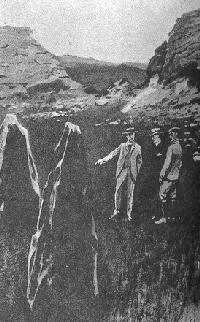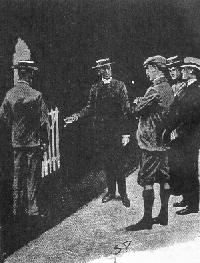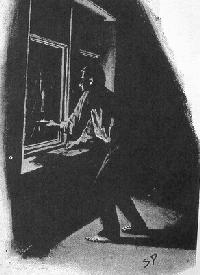The Hound of the Baskervilles.
ANOTHER ADVENTURE OF
SHERLOCK HOLMES
By Conan Doyle
Chapters VII & VIII
Watson begins this installment of the
Hound
of the Baskerville in the Strand by proclaiming
that "The fresh beauty of the following morning did something to
efface from our minds the grim and grey expression which had been left
upon both of us by our first experience at Baskerville Hall." 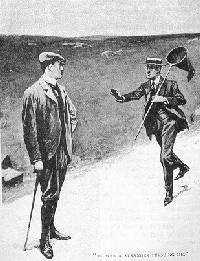 Paget follows this lead by lightening the hues of the frames in the
beginning of the episode, then darkening them as the themes of the tale
turn dark. Paget also eliminates the busy backgrounds of the frames
in the previous chapters in the city and and replaces them with minimalist
interpretations of the "wonderful place, the moor," thus moving us
from the harsh reality of the city to the mysterious possibilities of the
moors of Devonshire.
Paget follows this lead by lightening the hues of the frames in the
beginning of the episode, then darkening them as the themes of the tale
turn dark. Paget also eliminates the busy backgrounds of the frames
in the previous chapters in the city and and replaces them with minimalist
interpretations of the "wonderful place, the moor," thus moving us
from the harsh reality of the city to the mysterious possibilities of the
moors of Devonshire.
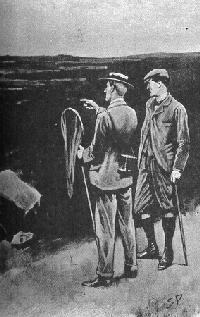 The
first such contrast is evident in the opening frame in which Stapleton
armed with a butterfly net greets Watson. Arm extended, and net cocked
over his left shoulder, Stapleton runs toward Watson, who awaits in a fashionable
pose suitable for the advertisement of which his neat attire and stance
mimic. In the background scattered boulders lie within the lightly
colored moor belying its pony trapping dangers.
The
first such contrast is evident in the opening frame in which Stapleton
armed with a butterfly net greets Watson. Arm extended, and net cocked
over his left shoulder, Stapleton runs toward Watson, who awaits in a fashionable
pose suitable for the advertisement of which his neat attire and stance
mimic. In the background scattered boulders lie within the lightly
colored moor belying its pony trapping dangers.
In the next scene, Watson takes a more inquisitive stance and
the "Great Grimpen Mire" forms a darker background as Stapleton, net at
parade rest, points our the location of a moor ponies demise.
The mood is again lightened and takes on Freudian
undertones with the 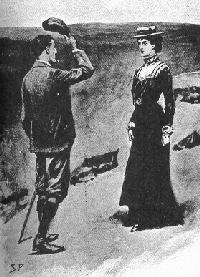 a
a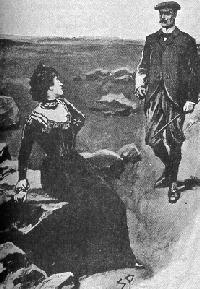 appearance
of Miss Stapleton in the next scene. Watson, taken aback by her "uncommon"
beauty tips his hat, only to be warned away. From what?
appearance
of Miss Stapleton in the next scene. Watson, taken aback by her "uncommon"
beauty tips his hat, only to be warned away. From what?
The answer may lie in the body language
of the next scene. The moor is again a light hue as Watson
skips toward Miss Stapleton. Seated sensually on a rock, hand
behind her thrusting out her ample bosom, she gazes toward the
man she had warned off minutes before. "You know the story of the
Hound" she asks coyly, and Watson declares his disbelief as he steps toward
her, crop in hand. Whereupon she speaks of her brother and her worry that
he might find that "... I have seen you." With a soul full of "vague
fears," Watson returns to the darkness of Baskerville Hall.
The past vs. the present and science vs. superstition
is present in the drawings of the meeting between Watson and Miss Stapleton
and Paget intensifies it in the final three images, At the original
locale of the Hound's first attack, Stapleton points out the scene.
The vestiges of the henges of Devonshire mark the spot, and despite Holmes'
declaration that he cares not "whether the sun moved around the earth
or the earth moved around the sun," he is a man of scientific reasoning.
The darkness of the henges Paget remind
us that this tale has not yet been cast into that corner of deductive reasoning.
Perhaps the ever gathering darkness of the images will overcome the
scientific methods that have yet to fail a man who battled vampires with
the declaration that "This agency stands flat-footed upon the ground, and
there it must remain. The world is big enough for us. No ghosts need apply."
Doyle's setting and Paget's depiction's challenge
this dictum.
The scenes and the tale continue to darken
as the party visits Sir Charle's death spot and ends with Barrymore signaling
across the moors with a light so enveloped in inky darkness that it cast
a dimness that dispels little the gloom of the room or the tale as set
forth by Sir Arthur Conan Doyle and as illustrated by Sidney Paget.
Take Care
SP
 Paget follows this lead by lightening the hues of the frames in the
beginning of the episode, then darkening them as the themes of the tale
turn dark. Paget also eliminates the busy backgrounds of the frames
in the previous chapters in the city and and replaces them with minimalist
interpretations of the "wonderful place, the moor," thus moving us
from the harsh reality of the city to the mysterious possibilities of the
moors of Devonshire.
Paget follows this lead by lightening the hues of the frames in the
beginning of the episode, then darkening them as the themes of the tale
turn dark. Paget also eliminates the busy backgrounds of the frames
in the previous chapters in the city and and replaces them with minimalist
interpretations of the "wonderful place, the moor," thus moving us
from the harsh reality of the city to the mysterious possibilities of the
moors of Devonshire.
 The
first such contrast is evident in the opening frame in which Stapleton
armed with a butterfly net greets Watson. Arm extended, and net cocked
over his left shoulder, Stapleton runs toward Watson, who awaits in a fashionable
pose suitable for the advertisement of which his neat attire and stance
mimic. In the background scattered boulders lie within the lightly
colored moor belying its pony trapping dangers.
The
first such contrast is evident in the opening frame in which Stapleton
armed with a butterfly net greets Watson. Arm extended, and net cocked
over his left shoulder, Stapleton runs toward Watson, who awaits in a fashionable
pose suitable for the advertisement of which his neat attire and stance
mimic. In the background scattered boulders lie within the lightly
colored moor belying its pony trapping dangers.
 a
a appearance
of Miss Stapleton in the next scene. Watson, taken aback by her "uncommon"
beauty tips his hat, only to be warned away. From what?
appearance
of Miss Stapleton in the next scene. Watson, taken aback by her "uncommon"
beauty tips his hat, only to be warned away. From what?
